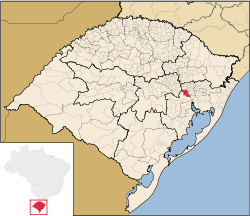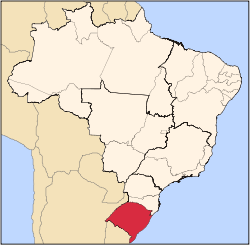Montenegro | |
|---|---|
 Location within Rio Grande do Sul | |
| Coordinates: 29°41′20″S51°27′39″W / 29.68889°S 51.46083°W | |
| Country | |
| State | Rio Grande do Sul |
| Population (2022) [1] | |
• Total | 64,322 |
| Time zone | UTC−3 (BRT) |
Montenegro is a municipality of the state of Rio Grande do Sul, Brazil. As of 2022, it has 64,322 inhabitants.
Contents
The town was established in 1847 to be settled primarily by German immigrants from the Hunsrück region of southwest Germany. The local language was Riograndenser Hunsrückisch for most of its history, and it is still spoken there after 150 years of the initial settlement. Today, however, Portuguese prevails, mostly as a result of the campaign of the "Nacionalização" (Nationalization) forcefully imposed on all German and Italian settled areas of southern Brazil by president and dictator Getúlio Vargas in the 1940s.





